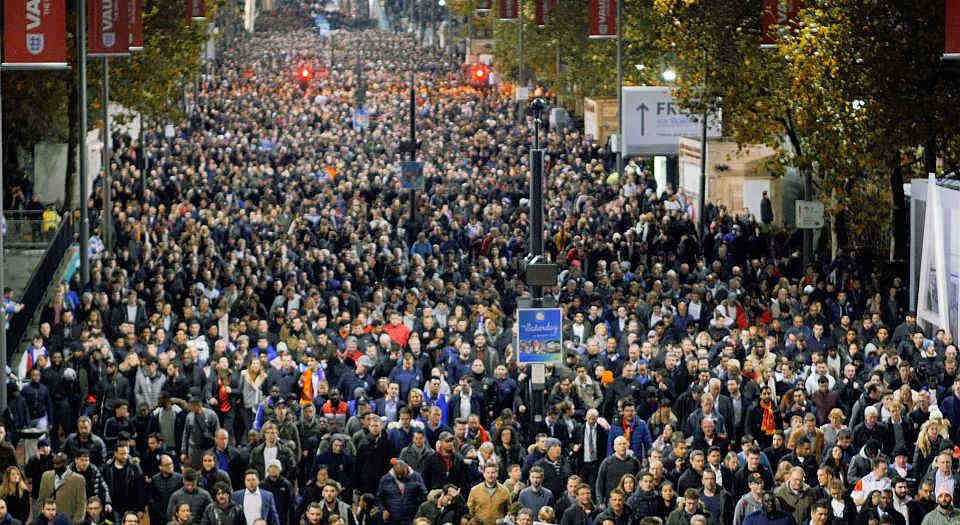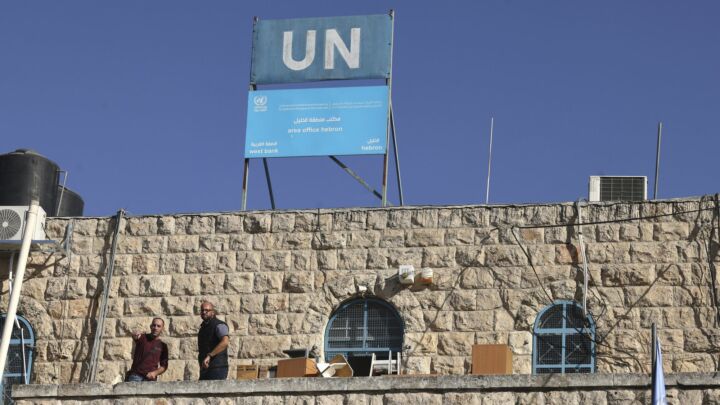The truth about the Houthis
They are not anti-Imperialist rebels – they are a vicious and reactionary Islamist cult.

Want to read spiked ad-free? Become a spiked supporter.
Over the past few months, Yemen’s Houthi rebels have been attacking container ships and energy tankers in the Red Sea. The Houthis say that these attacks are retaliation for Israel’s incursion into Gaza. This has delighted anti-Israel activists in the West, who have taken to the streets with a new chant: ‘Yemen, Yemen make us proud, turn another ship around.’
It’s clear that those Western leftists currently cheering on the Houthis know very little about this regressive movement.
Officially known as Ansar Allah (‘Supporters of God’), the Houthis have been in open rebellion against the Yemeni government since 2004. They now govern much of the populous west and north of Yemen. Since 2014, they have controlled the capital, Sanaa, forcing the internationally recognised Yemeni government to relocate to Aden, a port city on the southern coast. Today, the Houthis are the dominant force in a divided country.
To help us understand the rise of the Houthis, it is helpful to turn to Tribes and Politics in Yemen, a 2017 book by Austrian anthropologist Marieke Brandt. A product of extensive anthropological fieldwork in the Houthi stronghold of north-west Yemen, it shows that the Houthis’ rise owes more to the collapse of Arab nationalism in Yemen than any positive, internal dynamic in the movement itself. They have merely exploited the decay of the once powerful nationalist forces that drove the formation of the republic of North Yemen in 1962, before dominating Yemen proper after unification with Communist South Yemen in 1990.
The Houthis, like at least a third of Yemenis today, are Zaydi, which is a branch of Shia Islam. Like other Shia Muslims, the Zaydis believe that the position of state ruler, or Imamate, is hereditary. They trace their lineage back to Al-Qasim al-Rassi, who was a direct descendant of the Prophet Muhammed’s son-in-law, Ali ibn Abu Talib.
In the ninth century, Zaydi imam Yahya ibn al-Husayn, backed by members of the Sadah (Yemeni nobles), established control over northern Yemen. The Zaydi dynasty proceeded to rule over the north right up until 1962, when nationalists overthrew the Imamate and the Sadah. From this point, many Zaydi factions in northern Yemen felt marginalised.
When the nationalists took power in the 1960s, they appealed to the authority of Yemen’s populous Sunni population and of the tribal sheikhs. As Brandt explains, this was to create significant problems for the nationalists. The tribal groups were often feuding or at odds with one another. Ali Abdullah Saleh, who was president of North Yemen before becoming the first president of Yemen in 1990, likened handling the rivalry of the sheikhs to ‘dancing on the heads of snakes’.
By bringing the sheikhs into power, the republican government was effectively incorporating their divisions into government. Sheikhs were given seats in parliament that came to be thought of as hereditary. This itself started to undermine their actual usefulness for nationalists, as the sheikhs came to owe their authority more to government patronage than to any local support. Many locals accused them of spending more time in Sanaa than in their tribal areas.
The republican government also relied on support from Yemen’s Sunni sects. In this, they were helped by the Sunni theocrats of Saudi Arabia. But Saudi involvement was to have an unanticipated impact on certain sections of the Zaydi population, too. The Saudis had been helping to preserve and promote the Sunni Islamic revival movement of Salafism in the border regions and even in northern Yemen during the 1980s. This prompted certain Zaydi muslims, persecuted and sidelined since the overthrow of the imamate in 1962, to engage in their own religious revival movement. And it was this movement that would eventually birth the Houthis.
Zaydi revivalism was promoted by several important scholars, including Badreddin al-Houthi (1926-2010). Alongside his sons – Muhammed, Hussein and Yahya – and other supporters, al-Houthi built up the ‘Believing Youth’ movement in the 1980s. As the Believing Youth movement grew, it developed a reputation for political activism. It is now recognised as the Houthis’ first formal organisation.
It was al-Houthi’s son, Hussein, who led what would become the Houthi movement in a more militant direction. (It was after his assassination in 2004 that the Houthis acquired their name.) Hussein had spent time in Iran at various points, and had been inspired by the Ayatollah Khomeini’s theocratic regime. In 1993, he was elected to the Yemeni parliament as a representative of the Hizb al-Haqq party, before losing his seat in 1997.
Hussein’s frustration at the Zaydis’ political impotence, reinforced by the sheikhs’ domination of parliament, pushed him and his supporters into ever more direct opposition to the republican government. This opposition crystalised after al-Qaeda’s attack on the World Trade Centre in 2001 and the start of the war on terror.
Yemen’s nationalist leadership had been heavily punished for supporting Saddam Hussein in the Gulf War between the United States and Iraq in 1991. Around $70million in US aid was withdrawn, and Saudi Arabia expelled one million Yemeni migrant labourers, costing Yemen dear in lost remittances. Determined not to suffer the same punishment again, President Saleh, like so many tamed nationalists, offered the US fulsome support in the Iraq War in 2003.
The pro-US turn of the Yemeni government created an opening for the Houthis. They had struggled to find a way to turn the Zaydi revival movement from a religious campaign into a political movement. To this end, in 2000, Hussein coined the slogan, ‘Death to America, Death to Israel, a Curse upon the Jews, Victory for Islam’. The Believing Youth movement shouted this out at the end of so many prayers, that for a while it was known as the ‘Party of the Slogan’. According to Brandt, the reference to Israel was a reaction to the Second Intifada – the name given to the outbreak of hostilities between Palestinians and Israel between 2000 and 2005. Most of all, the slogan was a retrograde attempt to unify a fractured people against a nationalist government increasingly in thrall to the US.
The Saleh government’s support for the US invasion of Iraq boosted the Houthis, allowing them to lean even more heavily into anti-Americanism. In 2004, the government attempted to crack down on the Houthis’ Believing Youth movement. The Yemeni military’s subsequent battle with Hussein and other Houthis prompted the rebels to launch an intermittent insurgency against the republic.
As the Houthis rose during the latter half of the 2000s, Saleh’s government was increasingly struggling, thanks in part to the factional disputes among the sheikhs. ‘Wherever government patronage favoured one tribal group or sheikh at the expense of another, the Houthi movement found particularly favourable conditions to take root and flourish’, Brandt explains. Thereafter, Saleh’s attempts to cajole or force the Houthis into making peace kept on blowing up in his face. Every repressive measure ended up hurting allies and building up opposition to his regime.
Regional forces were also starting to fuel the conflict. From 2009 onwards, Saudi Arabia intervened openly on Saleh’s side in what was becoming a civil war. At the same time, Iran was clearly supporting the Houthis politically and probably militarily as well.
Saleh’s grip on power was slipping and his desperation was rising. Counter-insurgency efforts were stepped up and critics were jailed. Worse still, in 2011, Wikileaks exposed how he had given the Saudis the coordinates of his political rival and army general, Ali Mohsen al-Ahmar, so that they could bomb him – although the Saudis aborted the mission. In 2012, Saleh seemingly stepped back and ceded power to Abdrabbuh Mansour Hadi, then Yemen’s vice president.
The Houthis, meanwhile, were emboldened. After a succession of victories in the early 2010s, they moved on and took the capital, Sanaa, in 2014. Incredibly, they did so with the backing of Saleh, who continued to try to play a role in Yemen’s politics. The Houthis eventually executed him for treason in 2017.
Since 2015, Saudi Arabia, with the support of the US and the UK, has been engaged in a calamitous war against the Houthi regime. Hundreds of thousands have died. This conflict was only brought to an uneasy close last year after all sides committed to a ceasefire.
The Houthis today are the dominant force in a territory riven by factionalism. They control the populous north, while the south and east of Yemen are now governed by rival, nationalist forces. The Houthis have little to offer, let alone unify, Yemenis apart from a strategic alliance with Iran and a loathing of America and Israel. In the areas it controls, the Houthi regime is proving itself profoundly illiberal – it has suspended elections, and tortured and executed dissenters, homosexuals and anyone else who crosses it.
What few of the movement’s Western apologists understand is that the Houthis are simply filling a vacuum left by the collapse of the nationalist alternative. Insofar as the Houthis represent a challenge to the West, it is a reactionary one. It is only taking Yemen backwards. The Houthis’ rise is a blow to Yemenis, democracy and the wider Middle East.
James Heartfield’s latest book is Britain’s Empires: A History, 1600-2020, published by Anthem Press.
Picture by: YouTube.
Celebrate 25 years of spiked!
A media ecosystem dominated by a handful of billionaire owners, bad actors spreading disinformation online and the rich and powerful trying to stop us publishing stories. But we have you on our side. help to fund our journalism and those who choose All-access digital enjoy exclusive extras:
- Unlimited articles in our app and ad-free reading on all devices
- Exclusive newsletter and far fewer asks for support
- Full access to the Guardian Feast app
If you can, please support us on a monthly basis and make a big impact in support of open, independent journalism. Thank you.







Comments
Want to join the conversation?
Only spiked supporters and patrons, who donate regularly to us, can comment on our articles.